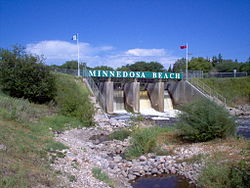- Minnedosa, Manitoba
-
Minnedosa The Minnedosa Dam on the Little Saskatchewan River. Location of Minnedosa in Manitoba Coordinates: 50°14′43″N 99°50′34″W / 50.24528°N 99.84278°WCoordinates: 50°14′43″N 99°50′34″W / 50.24528°N 99.84278°W Country Canada Province Manitoba Region Westman Rural Municipality Minto Incorporated March 2, 1883 (town) Government - Mayor Ray Orr Area - Total 15.2 km2 (5.9 sq mi) Population (2006)[1] - Total 2,474 - Density 162.2/km2 (420.1/sq mi) Time zone EST (UTC-6) - Summer (DST) EDT (UTC-5) Website Town of Minnedosa Minnedosa is a town in the southwestern part of the Canadian province of Manitoba. Situated 50 kilometres (32 mi) north of Brandon, Manitoba on the Little Saskatchewan River, the name means "flowing water" in Sioux. The population of Minnedosa reported in the 2006 Statistics Canada Census was 2,474.[1] The town is located in the Rural Municipality of Minto and bordered to the south by the Rural Municipality of Odanah.
Contents
History
Prior to the arrival of Europeans in the area of Minnedosa, the land was primarily traveled and used by the nomadic Ojibway, Cree, Assiniboine, and Sioux peoples.[2] John Tanner was the grandson of John Tanner who had been raised by a Shawnee. He was an American settler who arrived in the area in 1869. [2] The younger Tanner was the first Métis settler in the area and ran a ferry service across the Little Saskatchewan River. When a bridge was built in 1879, the ferry became obsolete and at the same time, a small town, Tanner's Crossing, was started nearby. John Armitage moved to the area around this time in 1877, and began to build a sawmill and gristmill. He joined together with Tanner to lay out a new town site and eventually Armitage had accumulated 3,800 acres (15 km2) of property.[2] Tanner named the new town Minnedosa, from the Cree word meaning "flowing water".[2]
Although Minnedosa once hoped to be a site of a river crossing for the Canadian Pacific Railway's transcontinental railway. The honour was initially given to Rapid City, while the actual site of the railway was later settled on a site much further south creating the city of Brandon.[3] In 1883 Minnedosa was incorporated as a town, it had experienced a period of growth from settlement schemes put forth by the Canadian government.[2] As Minnedosa became a town, this coincided with the actual arrival of the railway in 1883, bringing about more growth for the now quickly growing settlement.
A dam was proposed in 1907 and approved in December of the same year by the Government of Canada. It was built on the Little Saskatchewan River near the town. After several delays, the dam was completed in 1912, creating Minnedosa Lake. Water first flowed over the spillway on April 10, 1912. Minnedosa was the second community in the Province of Manitoba to generate its own hydroelectric power.[2] An earlier project in 1900 was also on the Minnedosa River and supplied power to the town of Brandon, Manitoba. Initially privately owned, the generation plant was taken over by the Manitoba Power Commission in 1920 and replaced by a diesel generation plant and by 1930, power from the provincial grid. The lake was used as a source of water for the town, for recreation, and for supplying the engines of the Canadian Pacific Railway.[2] On May 4, 1948 the spillway of the dam failed due to erosion of structure, and the resulting flood damaged many homes and businesses in the town. The spillway was not repaired until 1950 by the Prairie Farm Rehabilitation Administration.[4]
Since 1981 the Minnedosa Ethanol Plant has been producing ethanol to be blended into gasoline, as of late 2007 it has been expanded into one of the largest ethanol facilities in Canada. This plant is owned and operated by Husky Energy. [5]
Tourist sites
- Buffalo Park - located south of the Minnedosa Dam on PTH 262.
- Train Park located on the east side of Main Street Minnedosa.
- Nature Trail - 20 minute walk through wooded area adjacent to Buffalo Compound. Has a swinging bridge as well as a viewing tower.
- Heritage Park - A complex containing several buildings relating to the history of Minnedosa and its surrounding area.
- Lookout Tower - Approximately 40-foot (12 m) tower on top of a steep hill. Overlooks entire valley
- Trout Pond - Fishing spot stocked with many trout. Located at Heritage Village.
- Minnedosa is also the site of an annual event, called Rockin' the Fields of Minnedosa.
- Antons Lake is a short distance north-west of Minnedosa.
- Minnedosa Paddling Club, part of Manitoba Paddling Association[1].
Local media
- Minnedosa Tribune
Television
- CKND-TV-2 Channel 2 (Global)
- CKYB-TV Channel 4, Brandon (CTV)
- Access 12 Channel 12 (Local Community Programming)
- CBWFT-10 Channel 21, Brandon (Radio-Canada)
Schools
- There is a high school called Minnedosa Collegiate Institute, often called M.C.I.[2], and there is an elementary school called Tanner's Crossing School (T.C.S.)[3]. Both schools are part of the Rolling River School Division[4], which has its main bus dispatch and admin offices in town.
Notable natives and residents
Izzy Asper, the founder of CanWest Global Communications Corp
Kyle Parrott, 2010 Olympic Speed skater

Wasagaming 
Strathclair 
Neepawa  Minnedosa
Minnedosa 

Brandon  Subdivisions of Manitoba
Subdivisions of ManitobaSubdivisions Cities  Category:Manitoba ·
Category:Manitoba ·  Portal:Manitoba ·
Portal:Manitoba ·  WikiProject:Manitoba
WikiProject:ManitobaReferences
- ^ a b "2006 Canadian census". http://www12.statcan.ca/census-recensement/2006/dp-pd/prof/92-591/details/page.cfm?B1=All&Code1=4615075&Code2=46&Custom=&Data=Count&Geo1=CSD&Geo2=PR&Lang=E&SearchPR=01&SearchText=Minnedosa&SearchType=Begins. Retrieved 2010-07-21.
- ^ a b c d e f g "History of Minnedosa". The Town of Minnedosa. http://www.minnedosa.com/index.php?pageid=127. Retrieved 2010-07-21.
- ^ "History of Brandon". City of Brandon. http://www.city.brandon.mb.ca/main.nsf/Pages+by+ID/584. Retrieved 2010-07-02.
- ^ Robert M. Mummery (ed), Hold Back the Dam, Minnedosa District Heritage Foundation,Minnedosa, Manitoba Canada, 1998 ISBN 0-9683317-1-8, pages 8-11
- ^ huskyenergy.com
External links
Categories:- Manitoba geography stubs
- Towns in Manitoba
Wikimedia Foundation. 2010.



